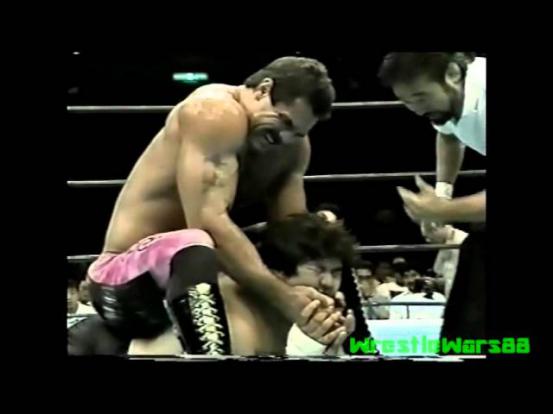- Commissioner’s statement on Ventura, Marte
- Ronnie O’Sullivan: Masters champion ‘felt so vulnerable’ in final
- Arron Fletcher Wins 2017 WSOP International Circuit Marrakech Main Event ($140,224)
- Smith challenges Warner to go big in India
- Moncada No. 1 on MLB Pipeline’s Top 10 2B Prospects list
- Braves land 2 on MLB Pipeline’s Top 10 2B Prospects list
- Kingery makes MLB Pipeline’s Top 10 2B Prospects list
- New Zealand wrap up 2-0 after Bangladesh implosion
- Mathews, Pradeep, Gunathilaka to return to Sri Lanka
- Elliott hopes for rain for Poli
The 50 Greatest Wrestlers Of The Last 50 Years: Who Is #32?
- Updated: May 14, 2016

The views expressed in this article are those of the author and do not reflect the opinions of WrestlingInc or its staff.
#32 Shinya Hashimoto
A round brawler from Toki City, Japan, Shinya Hashimoto rode a wave of insane popularity throughout the 1990s and became one of the most venerated wrestlers in Japanese history. Hashimoto was a top name for New Japan Pro Wrestling during the most profitable period in company history and also became the longest reigning IWGP World Heavyweight Champion in history. Hashimoto, probably more than any other Japanese wrestler, has the popularity that is most unique to fans from Japan. By that I mean that Hashimoto’s popularity was built heavily on trademarks of Japanese pop culture, mainly the code of the Samurai and fighting spirit. Comparing him to contemporaries, Keiji Mutoh (The Great Muta) and Mitsuharu Misawa, fans might not be that familiar with them, but watching one match or two it is easy to understand why those guys are considered all-time greats. On the contrary, Hashimoto might not seem like all that great to the casual fan, which ultimately effects his popularity in the West. The obvious modern comparison to Hashimoto is Samoa Joe. Like Samoa Joe, Hashimoto wasn’t known for his physique, but he was a tremendous brawler and had great charisma in the ring. Unsurprisingly, Hashimoto had a hand in training in Joe, and even wrestled him several times when Joe was working with Pro Wrestling ZERO1. After Hashimoto passed away in 2005, Joe summed up Hashimoto as a performer in a blog post. “When I 1st started in Japan my knowledge of Hashimoto was limited albeit somewhat educated. It was only when I began to wrestle across the ring from the man that I truly realized what it meant to be a star. Hashimotos ambiance did not lie in a flashy gimmickry, trend setting re-invention or the intangible coolness, of his musketeer brethren. Hashimoto had foregone the pomp and circumstance of wrestling and simply sought to be the embodiment of an ideal,” Joe wrote. “The ideal that was the founding principle of the dojo that produced him which was derived from the centuries old warrior customs of his culture. Hashimoto embodied Toukon, The Fighting Spirit.”
Joe continued to talk about what made Hashimoto a legend and how he passed that gift onto other wrestlers.
“Once at a preliminary training session, Hashimoto had quizzed a group of relatively clueless gaijin about the most important aspect of Professional Wrestling. Answers sprung forth pleading a case for “Technique” and “Psychology”, but Hashimoto simply pointed at his eyes and said “The Fire”. The fire, the burning spirit, the unyielding will, even in the face of insurmountable challenges. With a simple gesture and the most intense stare I had ever seen I understood all these things that I have just listed and nodded in compliance.”Hashimoto made his pro wrestling debut when he was 19 years old, losing to Naoki Sano on September 3, 1984. …
continue reading in source www.WrestlingInc.com
